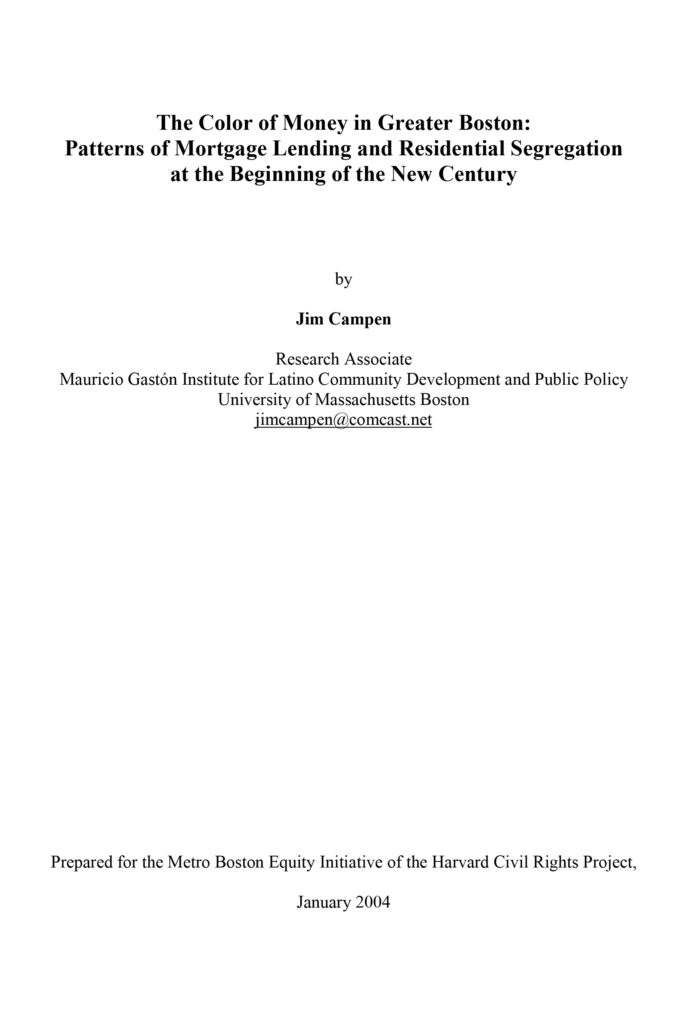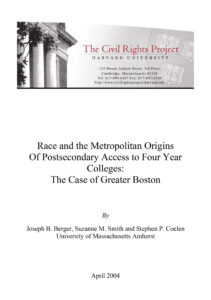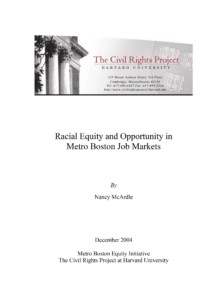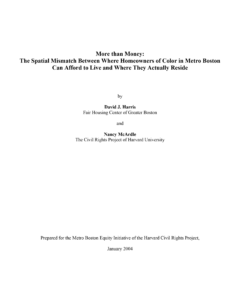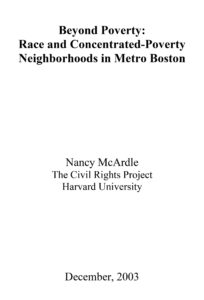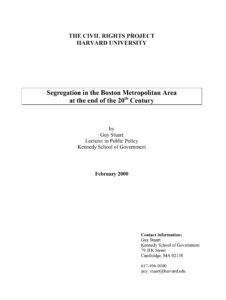Executive Summary
This paper investigates the relationship between mortgage lending disparities and segregated residential patterns in Metropolitan Boston. It finds that mortgage lending is operating to reproduce the region’s highly segregated residential patterns, although this relationship is considerably weaker for Asians than it is for blacks and Latinos. The paper defines the Boston metropolitan area as the 155 cities and towns that constitute the “Boston-Cambridge-Quincy Metropolitan New England City and Town Area” (Boston NECTA). It uses demographic data for these communities from the 2000 Census and information on lending from Home Mortgage Disclosure Act (HMDA) data for 2000 through 2002.
For lending in the Boston NECTA as a whole, findings include: (1) For home-purchase loan applications, the black denial rate of 18.3% was 2.57 times higher than the white rate of 7.1% and the Latino denial rate of 15.3% was 2.14 times higher. (2) These denial rate disparities cannot be explained by the fact that blacks and Latinos have, on average, lower incomes than whites; in fact, Black/white and Latino/white denial rate ratios tend to increase as incomes rise. (3) Black and Latino homeowners who refinanced their existing mortgages were over three times more likely to receive their loans from subprime lenders than were white borrowers. (4) These higher subprime loans shares cannot be explained by the lower income levels of blacks and Latinos; indeed, the subprime loan share for upper-income blacks was more than twice as high as that for low-income whites.
When the 155 communities in the Boston NECTA are grouped into three categories – Boston, the ten other high-density cities, and the remaining 144 cities and towns – mortgage lending is found to be operating to reproduce existing, highly-segregated patterns of residential location by race/ethnicity. That is, the shares of total home-purchase loans in the three types of communities that went to Asians, blacks and Latinos during the 2000-2002 period correspond quite closely these groups’ shares of households in 2000. Indeed, in the 144 Boston NECTA communities other than the eleven high-density cities, blacks accounted for only 1.6% of the households in 2000 – and received 1.6% of the home-purchase loans.
When residential and lending patterns are examined for the 155 individual cities and towns in the Boston NECTA, findings include:
- There is a very close correlation between the communities with the highest percentages of Asian, black, and Latino households and the communities with the highest percentages of loans to Asian, black, and Latino borrowers.
- A relatively small number of cities and towns account for the bulk of loans to blacks and Latinos; just four communities (Brockton, Randolph, Lynn, and Lowell) received more than half of all home-purchase loans to blacks in the 154 NECTA communities outside of Boston and five communities (Lawrence, Lynn, Chelsea, Brockton, and Revere) received more than half of all home-purchase loans to Latinos.
- There are many communities with very low Asian, black, and Latino household percentages and many in which very few – or even zero – loans are made to Asian, black, and Latino borrowers. Most striking, blacks constituted less than 1.0% of the total households in 100 of the 155 communities, and there were 95 communities in which they received less than 1.0% of total loans, including 15 communities in which they received no loans during 2000-2002.
- There is a strong relationship between the percentage of refinance loans in a community that are made by subprime lenders and the percentage of black and Latino households in the community.
The Metro Boston Equity Initiative is devoted to analyzing race relations and racial equity issues not simply in the city of Boston, but across the entire metropolitan region. Although greater Boston still has a large white majority and suburban sectors with very little diversity, immigration of Latinos and Asians is driving the region’s growth, and much of this population increase is taking place well outside of the city limits.
In compliance with the UC Open Access Policy, this report has been made available on eScholarship:
